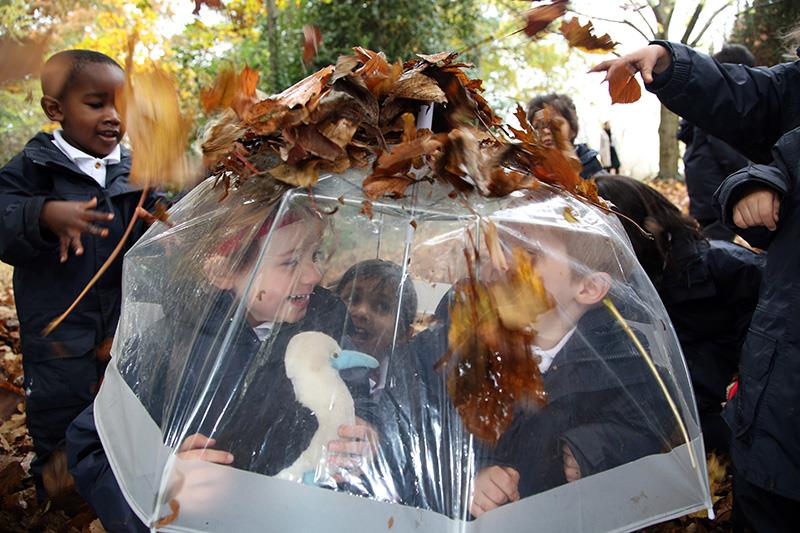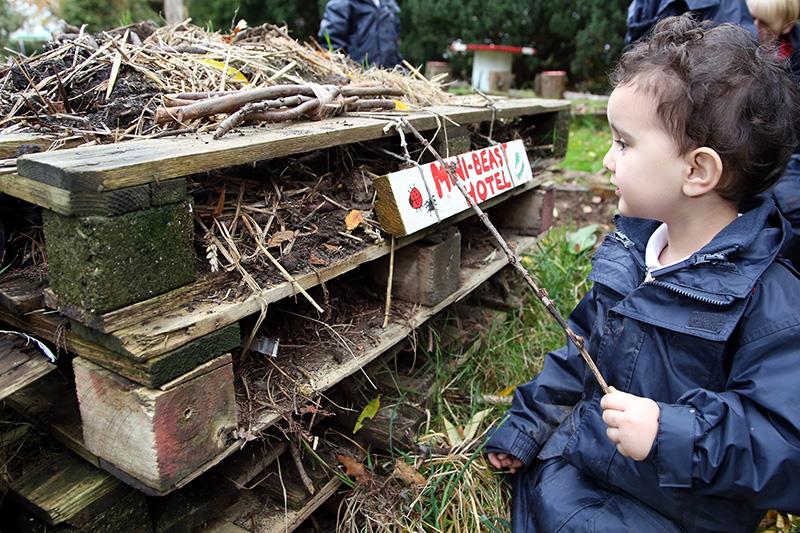You may have already read about the huge benefits that outdoor learning can bring, but how can you make it work throughout your whole school without needing extra timetable space, with minimum budget, and especially in urban areas where green space is limited?
What have you got and what is possible?
Unlike forest school, (which requires a woodland environment), outdoor learning can take place anywhere outdoors, including school fields and concrete playgrounds. Open your eyes and utilise the environment you have before you:
- Section off an area of your playground for outdoor learning. By designating an “area” this will motivate staff to both use it and to help develop it. It will also help to prevent anybody moving those “bottles full of mud” which were in fact wormeries that class 5 had built and were studying!
- In this outdoor area, create a log-circle. Contact your local tree surgeon or farm and notify them you are after log seats for your school to take learning outside. I’m sure they will be willing to help where they can.
- Dig a patch of grass up to create a designated planting area to grow your own vegetables. You could mark out your patch with logs or old planks of wood. If you have no grass to dig up, you could create a simple planter from recycled wood and place it in your outdoor learning area. Allow the children to care for and harvest the seeds and crops before cooking them on your fire-wok.
- Set a homework for everyone to bring in a small branch and create your own mini-beast log-pile habitats in your outdoor area. A simple pile of sticks can be a playground for mini-beasts. Three old pallets stacked and filled with natural materials also make great mini-beast mansions!
- Have a recycled-materials bin in your outdoor learning area from which children can build and create. This will teach them about materials and recycling while promoting their creativity.
- Leave the grass at the far end of the school field to grow wild and create a natural meadow. Simply ask your school gardener/caretaker to leave a patch of the field unmowed: less work for them and you also may find they take some interest in your project and offer to help with some ideas.
- If you are interested in providing bushcraft-type or tool/fire activities, you can buy raised, free-standing fire-woks. This means you can provide a fire on any surface, and take the fire-wok away at the end of the session. For tool use, you can create a “safe area” where tool work will take place. Start with tinkering tools such and screwdrivers and hammers, and build up to other tools once staff have the confidence and skills.
- Visit that interesting patch of land five minutes’ walk from your school. Connect and care for your local environment and develop a school spirit which cares for the environment in which they live.
- Above all, slow down, take a minute and look closer at what you have got in front of you. The possibilities are endless, despite any locational restrictions you may have.

The curriculum and schemes of work
Next, highlight any objectives in your current schemes of work and termly plans that could be better taught outdoors. Remember, outdoor learning isn’t an extra subject, it is a new way of teaching the same subjects and topics we already teach, just outdoors.
Many subject or topic objectives in your current school’s schemes of work can be better taught outside in order to increase pupil motivation, understanding and behaviour. Outdoor learning can bring learning to life through practical activities which relate to real-life experiences. You may find that many objectives from a variety of subjects can be facilitated in one single outdoor session; the cross-curricular opportunities are endless.
Outdoor learning also develops higher order thinking skills and experiential learning, which feeds into academic learning. Instead of waiting to be “spoon-fed” facts and figures inside the classroom, sometimes all the children need is a prompt or idea; the outdoor environment in itself often enables the children to test, adapt, experiment, consolidate and extend this idea independently. A sprinkle of creative teaching, initiates creative learning by pupils.
Once a week
Encourage every class to commit to outdoor lessons at least once a week. Many children at present receive time outdoors which is limited to playtimes or sporadic outdoor lessons during the summer months or more pleasant weather. Children that receive regular outdoor sessions throughout all seasons and weather conditions, develop personal and social skills, including resilience.
Venturing outside to learn every week throughout the whole year will mean that children will start to connect to their school and local environment and take a real sense of pride and care towards it. How can we promote a future generation of sustainability if the children we teach have never really connected to their outdoor environment in the first place? A connection with nature begins with solid roots in their primary years.
With weekly outdoor sessions, children will start to notice the difference between all four seasons in more detail. They will notice the similarities and differences between how the environment smells and feels. They will describe any species they find, which will develop not only classification and identification skills, but also consolidate mathematical and language skills. The children will experience the changes in materials and life-cycles and connect this to seasonal changes and scientific concepts.
The children will begin to write meaningful poems about the four seasons and write adventure stories which detail a character’s experiences in all five senses. They will consolidate and extend mathematical skills taught in the classroom to real-life experiences outside. Children will be testing, adapting, problem-solving and extending their learning while having fun.
Much outdoor provision at present is also limited to the early years. Older children still need to be outside. They still need to be experimenting, creating and exploring. Why develop a child’s creativity and connection with the outdoors in the early years, only to quash it by the time they reach upper primary? Many theories and objectives throughout key stage 2 can be better taught and learnt through utilising the outdoor environment. If this means training a member of staff to initiate or coordinate this move then any investment will be a good one. Various courses are available to provide staff with the skills and knowledge to implement a strategy which works for your school’s needs and constraints.
By adapting a whole-school approach to outdoor learning, colleagues can support each other and learning and skills can be built upon, as the children progress through your school. Training your staff to facilitate tool skills and fire-pit activities can not only increase pupils’ emotional intelligence, behaviour and motivation to learn, but could help to develop curricular skills in more creative ways.

Reach out to your community
Outdoor learning doesn’t have to be expensive. Spread the news in your local newspaper. Not only will the community love to hear your efforts to connect your pupils to the local environment, they may also be able to help in providing some valuable resources.
Reach out to your parents. Many parents work in related industries or have valuable skills which they may be willing to offer. Why not run an outdoor learning site set-up fun day and get everyone helping to make your ideas a reality. Many hands make light work and with everyone contributing, they will develop a real sense of pride for the school.
And use recycled materials, too. There must be hundreds of creative uses outside for old pallets. All a simple mud kitchen needs is a flat base, old kitchen equipment and mud! Put a plea out for old kitchen equipment or ask your kitchens for old dinner trays. Just make sure you check all equipment is safe and practical to use – outdoor equipment will get dirty and broken very quickly.
Don’t delay
Just by stepping outdoors you are opening up a whole new opportunity of learning. Teachers will experience an enrichment of resources and a deeper pupil understanding. Children will be able to connect classroom theories with reality. Pupils will develop the confidence to test their ideas and correct any misconceptions. They will gain self-confidence from exploring and observing. They will develop communication and team-work skills.
Children naturally learn by doing and moving, and the outdoor environment allows them to do this freely. Nature can actively help us all to de-stress, and this includes the teachers as well as the pupils. Outdoor learning should take place in all weathers and all times of the year. Outdoor learning is proven to not only increase pupil motivation, but also to improve behaviour.
- Alex Alves is a fully qualified forest school leader at Fairfield Preparatory School in Loughborough and director of Outdoor Learning Made Easy, which provides outdoor learning and forest school training, curriculum-linked lesson plans and guidance documents. Visit www.outdoorlearningmadeeasy.co.uk
